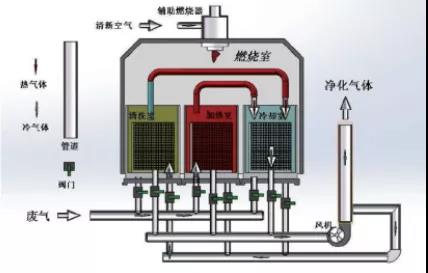2. The comprehensive purification efficiency of RCO in treating VOC organic waste gas is as high as 97%. Under the condition that the emission concentration of non-methane total hydrocarbons is lower than 50mg/m³, RCO cannot treat waste gas with a concentration higher than 1.67g/m³.
2) Energy saving
Thermal efficiency: refers to the ratio of the actual heat utilization to the theoretically usable total heat.
The surface heat loss and waste heat recovery ability of the RTO furnace body are two important factors that affect its thermal efficiency. After testing, the thermal efficiency of RTO is 97%, and the thermal efficiency of RCO is 95%.
For example: the exhaust gas temperature is 30°C, the RTO oxidation chamber temperature is 800°C, the inlet and outlet temperature difference is 20°C, and the outlet temperature is 50°C; RTO thermal efficiency: = (800-50)/(800-30) = 97.4%.
The exhaust gas temperature is 30°C, the RCO oxidation chamber temperature is 450°C, the inlet and outlet temperature difference is 20°C, and the outlet temperature is 50°C; RCO thermal efficiency: = (450-50)/(450-30) = 95.2%.
The filling volume of RTO regenerative bricks is 16m³. Under the cold furnace startup condition, the time for RTO to heat up to 800℃ is 1.5h. The filling volume of the RCO heat storage brick is 8m3, and the catalyst of the other ceramic carrier is 2.5m3. Under normal starting conditions, the RCO with less ceramic filling volume is started to heat up to 400 °C for 0.7h. The RCO consumes less heat during the cold start phase.
3) Economical:
From the perspective of economic performance of equipment manufacturing, the filling amount of RTO and RCO regenerative ceramics is 16m³ and 8m³ respectively, but RCO still needs to be filled with 2.7m³ catalyst (the space velocity of the catalyst is selected according to 15000 /h, the amount of catalyst △ = (air volume ÷ space velocity)×10/12=2.4, considering the actual filling of the catalyst, the actual catalyst to be filled is 2.7m³). The price of common brand precious metal catalysts is about 170,000 yuan/m³; the overall structure and other configurations of RCO and RTO are basically the same, that is, the investment of RCO equipment is about 1.2 times that of RTO equipment.
The service life of the RCO catalyst is 8,000-10,000 hours. If the production condition is 24 hours and 280 days/year, the service life of the catalyst is about 1.5 years, and the service life of the ceramic regenerator is about 8 years. The maintenance cost of the RTO due to the replacement of the ceramic regenerator is about 24,000 yuan/year, and the maintenance cost of the RCO due to the replacement of the catalyst and the ceramic regenerator is about 318,000 yuan/year. The maintenance of other components of the RCO is the same as that of the RTO.
4) Applicability :
RTO is suitable for the treatment of waste gas in the production process with high continuous emission concentration, and can effectively treat all VOCS organic waste gas volatilized in the production process;
RCO has fast cold start and low cost, and is suitable for waste gas treatment in intermittent production conditions. The exhaust gas must not contain S, P, AS, halogen and other components that poison the catalyst, and the trace dust in the exhaust gas needs to be deeply filtered, otherwise it will affect the effect of the catalyst; the corrosive exhaust gas containing S, Cl, etc. is in the RTO, RCO Can't handle it.
Additional TIPS: RTO applications in various industries




